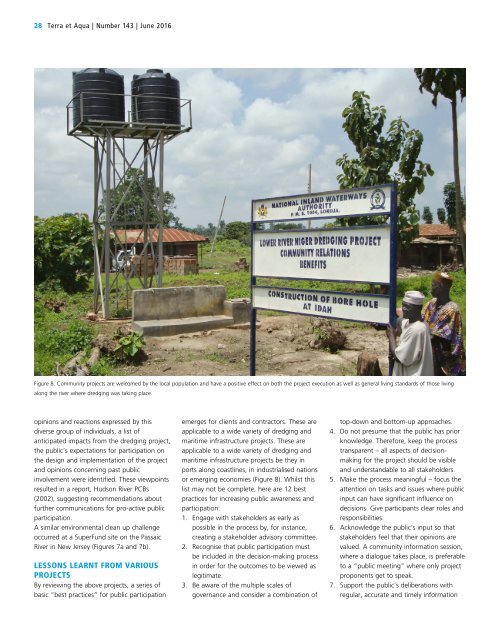TERRA AQUA
1U3mRWZ
1U3mRWZ
You also want an ePaper? Increase the reach of your titles
YUMPU automatically turns print PDFs into web optimized ePapers that Google loves.
28 Terra et Aqua | Number 143 | June 2016<br />
Figure 8. Community projects are welcomed by the local population and have a positive effect on both the project execution as well as general living standards of those living<br />
along the river where dredging was taking place.<br />
opinions and reactions expressed by this<br />
diverse group of individuals, a list of<br />
anticipated impacts from the dredging project,<br />
the public’s expectations for participation on<br />
the design and implementation of the project<br />
and opinions concerning past public<br />
involvement were identified. These viewpoints<br />
resulted in a report, Hudson River PCBs<br />
(2002), suggesting recommendations about<br />
further communications for pro-active public<br />
participation.<br />
A similar environmental clean up challenge<br />
occurred at a SuperFund site on the Passaic<br />
River in New Jersey (Figures 7a and 7b).<br />
LESSONS LEARNT FROM VARIOUS<br />
PROJECTS<br />
By reviewing the above projects, a series of<br />
basic “best practices” for public participation<br />
emerges for clients and contractors. These are<br />
applicable to a wide variety of dredging and<br />
maritime infrastructure projects. These are<br />
applicable to a wide variety of dredging and<br />
maritime infrastructure projects be they in<br />
ports along coastlines, in industrialised nations<br />
or emerging economies (Figure 8). Whilst this<br />
list may not be complete, here are 12 best<br />
practices for increasing public awareness and<br />
participation:<br />
1. Engage with stakeholders as early as<br />
possible in the process by, for instance,<br />
creating a stakeholder advisory committee.<br />
2. Recognise that public participation must<br />
be included in the decision-making process<br />
in order for the outcomes to be viewed as<br />
legitimate.<br />
3. Be aware of the multiple scales of<br />
governance and consider a combination of<br />
top-down and bottom-up approaches.<br />
4. Do not presume that the public has prior<br />
knowledge. Therefore, keep the process<br />
transparent – all aspects of decisionmaking<br />
for the project should be visible<br />
and understandable to all stakeholders.<br />
5. Make the process meaningful – focus the<br />
attention on tasks and issues where public<br />
input can have significant influence on<br />
decisions. Give participants clear roles and<br />
responsibilities.<br />
6. Acknowledge the public’s input so that<br />
stakeholders feel that their opinions are<br />
valued. A community information session,<br />
where a dialogue takes place, is preferable<br />
to a “public meeting” where only project<br />
proponents get to speak.<br />
7. Support the public’s deliberations with<br />
regular, accurate and timely information


